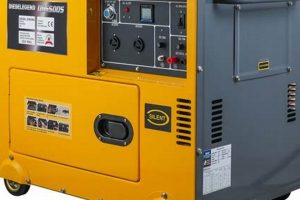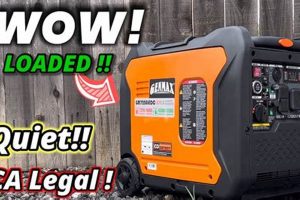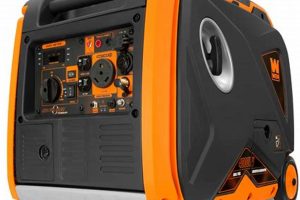Compact, easily transportable power sources designed for recreational vehicles exist to provide electricity without excessive noise. These units offer a balance between power output and sound reduction, allowing RV users to enjoy the comforts of electricity running appliances, lights, and electronics while minimizing disturbance to themselves and their neighbors in campgrounds or other outdoor settings. A typical example would be an inverter generator enclosed in a sound-dampening housing.
Low-noise operation is crucial for maintaining a peaceful environment, particularly in nature where quiet is often highly valued. The ability to operate essential appliances without the drone of a loud generator significantly enhances the RV experience. Furthermore, many campgrounds and recreational areas enforce noise level restrictions, making quiet generators a necessity for compliance. The development of quieter generators reflects the growing demand for more environmentally conscious and considerate power solutions in recreational settings. Historically, generators were often noisy, but advances in technology, such as inverter technology and improved muffler designs, have led to significantly quieter options.
This discussion will further explore the critical factors to consider when selecting a suitable low-noise generator for RV use, including power output, fuel efficiency, runtime, and different types of noise reduction technology. It will also delve into maintenance best practices and safety considerations for optimal performance and longevity.
Tips for Selecting and Using Low-Noise RV Generators
Choosing and operating a generator designed for minimal noise output requires careful consideration of several factors. The following tips offer guidance for ensuring a positive experience.
Tip 1: Prioritize Inverter Technology: Inverter generators generally produce less noise than conventional generators. Their variable engine speed adjusts to the power demand, resulting in quieter operation and better fuel efficiency.
Tip 2: Consider Decibel Ratings: Look for generators with a decibel (dB) rating of 60 dB or lower, measured at a distance of 23 feet. This level is generally considered quiet enough for most campground settings.
Tip 3: Evaluate Power Needs: Determine the wattage required to run essential appliances and electronics simultaneously. Choosing a generator with sufficient power output prevents overloading and excessive noise.
Tip 4: Check for Sound-Dampening Features: Look for features such as insulated enclosures, mufflers, and vibration-dampening mounts that contribute to quieter operation.
Tip 5: Maintain Proper Distance: Position the generator a safe distance away from the RV and neighboring campsites to minimize noise impact. Adhere to campground regulations regarding generator placement.
Tip 6: Regular Maintenance is Key: Follow the manufacturer’s recommendations for oil changes, air filter cleaning, and spark plug replacement to ensure optimal performance and minimize noise.
Tip 7: Utilize Ground Cover: Placing the generator on a level, stable surface such as a rubber mat or a piece of plywood can help reduce vibration and noise transfer.
By adhering to these tips, RV users can significantly reduce noise pollution while enjoying the benefits of a reliable power source. This leads to a more peaceful and enjoyable camping experience for everyone.
This information provides a solid foundation for making informed decisions regarding quiet RV generator selection and usage. The following section will conclude with a summary of key points and further resources for continued research.
1. Sound-Dampened Enclosures
Sound-dampened enclosures play a crucial role in achieving quiet operation in portable RV generators. These specialized housings are designed to minimize noise pollution, creating a more pleasant environment for RV users and surrounding campers. Understanding the key facets of these enclosures provides insight into their effectiveness.
- Materials and Construction
Sound-dampened enclosures utilize specific materials and construction techniques to absorb and deflect sound waves. Common materials include dense foam, sound-absorbing blankets, and strategically placed baffles. The enclosure’s construction aims to create an airtight seal, preventing noise leakage. An example is a double-walled enclosure with an inner layer of absorptive material and an outer layer of a rigid, sound-reflecting material.
- Ventilation and Cooling
While minimizing noise is paramount, proper ventilation and cooling are essential for generator performance and safety. Enclosures incorporate carefully designed vents and airflow pathways to ensure adequate cooling while minimizing noise escape. These vents often feature intricate designs or sound baffles that allow air to pass through while deflecting sound waves. For example, some enclosures use labyrinthine vents that effectively reduce noise while maintaining airflow.
- Accessibility and Maintenance
Sound-dampened enclosures are designed with accessibility in mind. Access panels and removable sections allow for easy access to the generator’s controls, fuel tank, and other components for maintenance and refueling. Well-designed enclosures provide convenient access without compromising noise reduction. An example is an enclosure with hinged access panels secured with vibration-dampening latches.
- Impact on Overall Noise Reduction
The effectiveness of a sound-dampened enclosure is measured in decibels (dB). High-quality enclosures can significantly reduce noise levels, often by 10-20 dB or more compared to an open-frame generator. This reduction can make a substantial difference in perceived loudness, creating a more peaceful camping experience. A comparison of dB levels between an enclosed and unenclosed generator highlights the significant impact of these enclosures.
By combining these elements, sound-dampened enclosures significantly contribute to the quiet operation of portable RV generators. This technology enables RV enthusiasts to enjoy the convenience of power without disturbing the tranquility of their surroundings. The quieter operation fosters a more positive and considerate camping experience, reflecting a growing awareness of noise pollution in natural environments.
2. Inverter Technology
Inverter technology plays a crucial role in the evolution of quiet portable RV generators. Unlike conventional generators that operate at a fixed speed, inverter generators utilize advanced electronics to produce pure sine wave AC power. This fundamental difference allows for variable engine speed, directly correlating with quieter operation and improved fuel efficiency.
- Variable Engine Speed
A key advantage of inverter technology is the ability to adjust engine speed based on power demand. When less power is required, the engine slows down, reducing noise output and fuel consumption. Conversely, the engine speeds up to meet higher power demands. This dynamic adjustment results in significantly quieter operation compared to traditional generators that run at a constant speed, regardless of the load. For instance, running a small fan requires less power and results in a slower, quieter engine speed compared to powering a larger appliance like an air conditioner. This adaptability is crucial for maintaining a peaceful environment.
- Pure Sine Wave Power
Inverter generators produce clean, stable power, replicating the quality of electricity supplied by utility companies. This “pure sine wave” power is essential for sensitive electronic devices such as laptops, smartphones, and medical equipment. Conventional generators often produce a “modified sine wave” which can damage these devices. The clean power delivery of inverter technology not only protects electronics but also contributes to quieter operation by eliminating electrical noise and interference. This clean power ensures compatibility with a wide range of devices without the risk of damage or disruption.
- Fuel Efficiency
The variable engine speed of inverter generators contributes to significant fuel savings. By adjusting engine speed to match power demand, these generators consume less fuel than conventional generators that run at a constant speed, even under low loads. This efficiency translates to longer runtimes on a single tank of fuel, reducing the frequency of refueling and further minimizing noise disruptions. For example, an inverter generator might consume significantly less fuel overnight while powering only a few small appliances, resulting in fewer refueling trips and less noise overall.
- Parallel Operation for Increased Power
Some inverter generators offer parallel operation capabilities, allowing two units to be connected to double the power output. This feature provides a scalable power solution for larger RVs or situations requiring higher wattage. When operating in parallel, the combined units still benefit from inverter technology’s quiet operation and fuel efficiency. This offers a flexible and efficient solution for varying power needs without compromising on noise levels.
The integration of inverter technology significantly enhances the quiet operation, fuel efficiency, and overall performance of portable RV generators. This advancement directly addresses the need for quieter power solutions in recreational settings, contributing to a more peaceful and enjoyable camping experience. The benefits extend beyond noise reduction, encompassing improved fuel economy and cleaner power delivery, making inverter generators a preferred choice for environmentally conscious and technologically discerning RV enthusiasts.
3. Low dB Ratings
Decibel (dB) ratings are a critical factor in assessing the noise output of portable RV generators. Lower dB ratings signify quieter operation, a key consideration for maintaining peaceful campsites and complying with noise regulations. Understanding dB levels and their implications helps RV users select generators that minimize noise pollution and enhance the overall camping experience.
- Understanding Decibels
Decibels are a logarithmic unit measuring sound intensity. A 10 dB increase represents a tenfold increase in perceived loudness. For context, a whisper is around 30 dB, normal conversation is about 60 dB, and a loud motorcycle engine is around 100 dB. In the context of RV generators, a lower dB rating translates to a less intrusive sound profile, promoting a more tranquil environment for oneself and fellow campers.
- Typical dB Ratings for Quiet Generators
Generators marketed as “quiet” typically have dB ratings between 50 and 60 dB, measured at a distance of 23 feet (7 meters). This distance represents a standard measurement point used for comparing generator noise levels. Generators with dB ratings below 50 are considered exceptionally quiet, while those above 60 dB might be perceived as intrusive in a quiet camping setting. For example, a 50 dB generator operating at 23 feet away would be significantly quieter than a typical conversation.
- Impact of Distance on Perceived Noise
Sound intensity decreases with distance. Doubling the distance from a sound source generally reduces the noise level by approximately 6 dB. Therefore, strategically positioning a generator further away from the RV and neighboring campsites can significantly reduce the perceived noise. Understanding this principle helps users optimize generator placement to minimize disturbance. Placing a generator 46 feet away, rather than 23 feet, effectively reduces the perceived noise level.
- Regulations and Considerations
Many campgrounds enforce noise restrictions, often limiting generator noise to specific dB levels and designated operating hours. Choosing a generator with a low dB rating ensures compliance with these regulations and promotes courteous camping practices. Respecting noise limitations contributes to a positive and harmonious camping environment for everyone. Consulting campground regulations before arrival is crucial to avoid potential issues. This information helps ensure a peaceful and enjoyable camping experience for all.
Prioritizing low dB ratings is essential for selecting a portable RV generator that minimizes noise pollution. Understanding how decibels are measured, typical ratings for quiet generators, the impact of distance on perceived noise, and campground regulations allows RV users to make informed decisions and contribute to a more peaceful and respectful camping environment. Selecting a generator with a low dB rating directly translates to a quieter, more enjoyable experience for all.
4. Proper Maintenance
Proper maintenance is essential for ensuring the quiet operation of portable RV generators. A well-maintained generator operates more efficiently and produces less noise than a neglected one. Several maintenance tasks directly impact noise levels. Regular oil changes maintain proper lubrication, reducing friction and engine noise. Air filter cleaning ensures adequate airflow, preventing the engine from overworking and producing excessive noise. Spark plug replacement maintains efficient combustion, minimizing misfires and associated noise. Addressing worn or damaged components, such as mufflers and exhaust systems, prevents noise leakage and excessive vibration. For example, a clogged air filter can cause a generator to run louder and less efficiently due to restricted airflow. Ignoring a damaged muffler can lead to significantly increased exhaust noise, disturbing nearby campers and potentially violating campground regulations.
Neglecting maintenance can lead to several noise-related issues. Worn spark plugs can cause misfires, resulting in loud popping sounds. A dirty air filter restricts airflow, forcing the engine to work harder and produce more noise. Low oil levels increase friction and engine noise. Damaged mufflers and exhaust systems can leak exhaust fumes and amplify engine noise. These issues not only increase noise pollution but also reduce the generator’s efficiency and lifespan. Regular maintenance, following manufacturer recommendations, mitigates these risks and ensures quiet, efficient operation. For instance, a generator operating with low oil levels may produce a noticeable knocking sound and overheat, potentially causing permanent damage and increased noise output.
Prioritizing proper maintenance is crucial for preserving the quiet operation of portable RV generators. Regularly scheduled maintenance, following manufacturer guidelines, minimizes noise pollution and ensures optimal performance and longevity. This proactive approach not only benefits individual users but also contributes to a more peaceful and respectful camping environment for everyone. Addressing maintenance issues promptly prevents minor problems from escalating into major, noise-inducing repairs. This commitment to proper care ensures that the generator remains a quiet and reliable power source for years to come.
5. Strategic Placement
Strategic placement of portable RV generators significantly impacts their perceived noise levels. Sound, like ripples in water, propagates outward from the source. Positioning a generator further from the RV and neighboring campsites reduces the sound intensity reaching those locations. Obstacles such as trees, bushes, and terrain features can further disrupt sound waves, decreasing noise pollution. Directing the generator’s exhaust away from occupied areas also minimizes noise impact. For example, placing a generator behind a thick bush and downwind from the campsite can significantly reduce the noise heard at the campsite. Conversely, placing it beside the RV’s thin wall, facing neighboring campsites, maximizes noise transmission and disturbance.
Several factors influence optimal generator placement. Distance is paramount; increasing the distance between the generator and listeners dramatically reduces perceived noise. Obstacles such as vegetation or structures can absorb and deflect sound waves. Wind direction plays a crucial role; downwind placement carries sound away from listeners, while upwind placement directs sound towards them. Terrain features can also be utilized to dampen sound propagation. Understanding these factors allows users to strategically position the generator for minimal noise impact. Consider a scenario where a slight rise in the terrain exists behind the campsite. Placing the generator behind this rise creates a natural sound barrier, reducing noise at the campsite. Furthermore, orienting the generator’s exhaust outlet towards the rise further minimizes noise transmission.
Strategic placement is a crucial yet often overlooked aspect of minimizing noise pollution from portable RV generators. Consideration of distance, obstacles, wind direction, and terrain significantly impacts the effectiveness of noise reduction efforts. Understanding these principles empowers RV users to create a quieter, more respectful, and enjoyable camping experience for themselves and their neighbors. Failure to consider these factors can negate the benefits of even the quietest generator models. Strategic placement, combined with other noise reduction techniques, contributes significantly to a more peaceful and harmonious camping environment.
Frequently Asked Questions about Quiet Portable RV Generators
This section addresses common inquiries regarding quiet portable generators for recreational vehicles. Clear and concise answers provide practical information for informed decision-making.
Question 1: How is generator noise measured?
Generator noise is measured in decibels (dB), a logarithmic unit quantifying sound intensity. Measurements are typically taken at a distance of 23 feet (7 meters) from the operating generator. Lower dB values indicate quieter operation.
Question 2: What dB level is considered quiet for a generator?
Generators with dB ratings between 50 and 60 at 23 feet are generally considered quiet. Models below 50 dB are exceptionally quiet, while those above 60 dB may be perceived as noisy in a quiet environment.
Question 3: What technologies contribute to quiet generator operation?
Inverter technology, sound-dampened enclosures, advanced muffler designs, and vibration-dampening mounts contribute significantly to reducing generator noise output.
Question 4: How does distance affect generator noise?
Sound intensity decreases with distance. Doubling the distance from the generator typically reduces noise levels by approximately 6 dB.
Question 5: Are there regulations regarding generator noise in campgrounds?
Many campgrounds enforce noise restrictions, often limiting generator operation to specific dB levels and designated hours. Consulting campground regulations before arrival is essential.
Question 6: How does maintenance affect generator noise?
Regular maintenance, including oil changes, air filter cleaning, and spark plug replacement, ensures optimal engine performance and minimizes noise output. Neglecting maintenance can lead to increased noise levels.
Understanding these key aspects of quiet generator operation facilitates informed selection, proper usage, and a more enjoyable camping experience for all.
The next section explores specific generator models and their respective noise levels, providing further guidance for selecting the quietest option for individual needs.
Portable RV Generators Quiet
Minimizing noise pollution from portable generators is crucial for preserving the tranquility of outdoor environments and ensuring a positive recreational experience. This exploration has highlighted the critical factors contributing to quiet operation, including inverter technology, sound-dampened enclosures, low dB ratings, proper maintenance, and strategic placement. Technological advancements continue to refine noise reduction techniques, offering increasingly quieter power solutions for RV enthusiasts. Careful consideration of these factors empowers informed decisions, enabling selection of generators that balance power needs with minimal noise impact. Understanding the principles of sound propagation and the importance of responsible generator usage fosters a more considerate and harmonious camping experience.
The pursuit of quieter portable power solutions reflects a growing awareness of environmental responsibility and respect for shared outdoor spaces. Continued development of noise reduction technologies promises even quieter generators in the future, further enhancing the enjoyment of nature. Embracing these advancements and adhering to responsible usage practices ensures the preservation of peaceful environments for generations to come. The commitment to quiet operation represents a significant step towards minimizing the environmental impact of recreational activities and fostering a more sustainable approach to outdoor power consumption.






